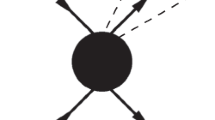Summary
We admit the correctness 1) of theV- A current-current lepton couplings and 2) of the calculations to first order in Fermi coupling constants. In the first Section of this paper, we demonstrate in general, and show in an explicit example, the following property: if the electrons were the only charged particles existing in nature, the observable vector Fermi interaction between electron and neutrino would be proportional to the photon renormalization constant which could thereby be measured, its nullity implying the compositeness of the photon. This result is, apart from a factor √Z 3,related to the expression given by Cheng and Bludman for the neutrino charge radius. In the second Section of this paper, we extend this argument by taking into account the existence of the two neutrinos (v eandv μ)and of the various charged particles. We first deduce from experimental data that the contribution of all the meson and baryon states to theZ 3constant, is ≈ 2α/3. IfZ 3may be null, this contribution is negligible with respect to that of the leptons. It follows that the measurement of the observable Fermi interactions ofv eandv x03BC; with the various charged particles, determinesZ 3and the constantx, ratio of the muonic to the electronic contribution toZ 3. We discuss the two equally favoured hypothesesx ≈ andx ≪ 1, and the consequences of the existence of other leptons than e and μ. The present limit onv μ- p elastic scattering implies the following three possibilities:a) Ifx ≈ 1 and if only e and μ leptons exist, thenZ 3>0.5.b) If Z3 = 0, either there exist at least two unknown types of leptons different from e and μ, orx < 1/3.c) Hypothesis 1 or 2 is wrong. The measurement of thev eelastic scattering with charged particles can distinguish between these possibilities.
Riassunto
Si ammette la correttezza 1) degli accoppiamenti leptoniciV-A corrente-corrente e 2) dei calcoli di primo ordine nelle costanti di accoppiamento di Fermi. Nella prima Sezione di questo articolo si dimostra in generale e si mostra con un esempio esplioito la seguente proprietà : se gli elettroni fossero le sole particelle cariclie esistenti in natura, l’interazione di Fermi vettoriale, osservabile fra l’elettrone ed il neutrino, sarebbe proporzionale alla costante di rinormalizzazione del fotone che potrebbe quindi essere misurata, implioando la sua nullità che il fotone è composito. Questo risultato è, a parte un fattore √Z 3,in relazione con l’espressione data da Cheng e Bludman per il raggio della carica del neutrino. Nella seconda Sezione dell’articolo si estende questo ragionamento tenendo conto dell’esistenza dei due neutrini (v eev μ)e delle varie particelle cariche. Si deduce dapprima dai dati sperimentali che il contributo di tutti gli stati mesonici e barionici alla costanteZ 3è ≈2α/3. SeZ 3potesse essere nullo, questo contributo sarebbe trascurabile rispetto a quello dei leptoni. Segue che la misura delle interazioni di Fermi osservabili delv ee dalv μcon le varie particelle cariche determinaZ 3e la costantex, rapporto fra il eontributo dato aZ 3dai muoni e dagli elettroni. Si discutono le due ipotesi egualmente favoritex ≈ 1e x–<l e le conseguenze dell’esistenza di altri leptoni oltre e e μ Il présente limite dello scattering elastico vμ-p implica le seguenti tre possibilità :a) Sex ≈ e se solo i leptoni e e μ, esistono, alloraZ 3–< 0.5.b) SeZ 3= 0, o esistono almeno due tipi sconosciuti di leptoni diversi da e e μ., ox –< 1/3c) L’ipotesi 1 o l’ipotesi 2 è sbagliata. La misura dello scattering elastico delv econ le particelle oariche puo distinguere fra queste possibilità.
Similar content being viewed by others
References
L. De Bboglie:Une nouvelle théorie de la lumière (Paris, 1940).
O. W. Grenberg etA. S. Wightmann:Phys. Rev.,99, 975 (1955);B. Ferretti etI. Venturi:Nuovo Cimento,35, 644 (1965);W. A. Perkins:Phys. Rev.,137, B 1291 (1965).
B. Jouvet:Compt. Rend.,237, 1642 (1953);Journ. Math.,33, 201 (1954).
B. Jouvet:Nuovo Cimento,3, 1133 (1956);5, 1 (1957).
J. Bialynicki-Birula : Phys. Rev.,130, 465 (1963).
J. D. Bjorken:Ann. Phys.,24, 174 (1963).
D. Lurié etA. J. Macfarlane:Phys. Rev.,136, B 816 (1964).
Voir réf. (3-6) dans l’article (7).
M. T. Vaugh, R. Aaron etR. D. Amado:Phys. Rev.,124, 1258 (1961).
J. C. Houard:Nuovo Cimento,35, 194 (1965).
S. Weinberg:Phys. Rev.,130, 776 (1963);137, B 672 (1965).
Y. Ataka:Nucl. Phys.,43, 60 (1963);Prog. Theor. Phys.,30, 916 (1963).
B. Jouvet:Phys. Lett.,6, 307 (1963).
R. E. Marshak etE. C. G. Sudarshan:Phys. Rev.,109, 1860 (1958);Proceed. Padua-Venice Conference (Sept., 1957);R. P. Feynman etM. Gell-Mann:Phys. Rev.,109, 193 (1958).
W. K. Cheng etS. M. Bludman:Phys. Rev.,136, B 1787 (1964). Voir aussi:Ya. B. Zeldovich etA. M. Perelomov:Sov. Phys. JETP,12, 777 (1961);M. A. Ruderman: UCRL-10336 (1962), non publié.
J. Schwinger [Phys. Rev,74, 1439 (1948)];W. Pauli etF. Villars [Rev. Mod. Phys.,21, 434 (1949)].
B. Jouvet etJ. P. Adam:Nuovo Cimento,29, 1275 (1963).
J. Bernstein, M. Ruderman etG. Feinberg:Phys. Rev.,132, 1227 (1963).
F. Reines etW. R. Kropp:Phys. Rev. Lett.,12, 457 (1964).
B. W. Lee, K. T. Mahanthappa, I. S. Gerstein andM. L. Whippman:Ann. Phys.,28, 466 (1964).
A. Jacquemin etB. Jouvet:Nuovo Cimento,37, 20 (1965).
L. M. Hand, D. G. Miller etR. Wilson:Rev. Mod. Phys.,35, 335 (1963).
J. M. Abillon:Compt. Rend.,257, 1011 (1963)
L. Landau: dansNiels Bohr and the Development of Physics (London, 1955), p. 56.
H. Bingham, H. Burmeister, D. Cundy, P. G. Innocenti, A. Lecourtois, E. Møllerud, G. Myatt, M. Paty, D. Perkins, C. A. Ramm, K. Schultze, H. Sletten, K. Soop, R. G. P. Voss etH. Yoshiki:Proceed. Sienna Conference on Elementary Particles, vol.1, (1963), p. 555.
O. Klein:Suppl. Helv. Phys. Acta,4, 59 (1956);W. Pauli:Suppl. Helv. Phys. Acta,4, 68 (1956).
B. Jouvet:Nuovo Cimento,2, 941 (1955) et réf. (4).
J. Bernstein etT. D. Lee:Phys. Rev. Lett.,11, 512 (1963);Ph. Meyer etD. Schiff:Phys, Lett.,8, 217 (1964);W. K. Cheng etS. A. Bludman: réf. (15).
Author information
Authors and Affiliations
Additional information
Ce travail a bénéficié de l’aide du Commissariat à l’Energie Atomique.
Rights and permissions
About this article
Cite this article
Jouvet, B. Diffusions élastiques des neutrinos et structure du photon. Nuovo Cim 38, 951–978 (1965). https://doi.org/10.1007/BF02748609
Received:
Published:
Issue Date:
DOI: https://doi.org/10.1007/BF02748609



